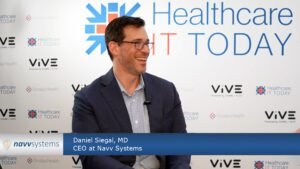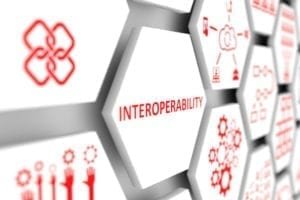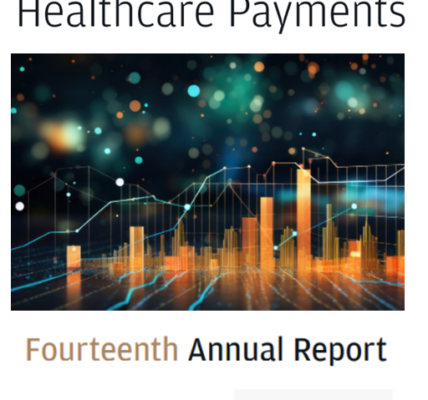Healthcare organizations are increasingly reliant on mobile devices for daily operations, enabling tasks that range from clinical communications to electronic record access. The proliferation of devices brings new challenges including loss, security risks, and a strain on IT resources. Managing those devices effectively not only reduces risk, but also improves workflow efficiency says Daniel Siegal, MD, CEO of Navv Systems, a company that offers a mobile device management platform.
Healthcare IT Today sat down with Dr. Siegal to discuss the challenges of managing mobile devices in healthcare.
Healthcare Has Embraced Mobile Devices
According to Pew Research, as of 2023, 97% of Americans own a cellphone and 90% own a smartphone – up from just 35% in 2011. The use of mobile technologies in healthcare has mirrored this consumer trend.
In the 2015 HIMSS Mobile Technology Survey, 90% of respondents were already using mobile devices within their organizations to engage patients in their healthcare. A more recent study from 2023 showed:
- Almost 90% of clinicians used a smartphone during clinical practice
- More than 25% of clinicians used a tablet during clinical practice
- Just over 60% of clinicians used a medical app during clinical practice
“We have seen the transition from fixed workstations everywhere, to mobile devices,” said Dr. Siegal. “When people see what they can do with their smartphones at home, they want that same experience at work.”
As usage of mobile devices has increased, however, so too has the burden of managing those devices for enterprise IT managers.
The Challenge of Mobile Devices in Healthcare
According to Dr. Siegal, some of the common challenges of managing mobile devices in a healthcare organization include:
- The devices are small and easily lost/misplaced by staff
- The devices have access to sensitive patient and staff information
- There are insufficient IT resources to manage all the mobile devices in use at a healthcare organization
“The loss of mobile devices is not malicious, for the most part,” explained Dr. Siegal. “Healthcare staff are busy. They get interrupted. They have a lot going on. They might put the device down or it might fall out of their pocket and end up in a laundry bin or a trash can. Even with GPS, it is difficult to recover these devices, especially inside large buildings like hospitals.”
The net result: frustrated staff, financial losses for the organization, and headaches for the IT department.
Managing Mobile Devices at Scale in Healthcare
When a hospital employee loses their mobile device, they can not easily retrieve patient information, record a note, order labs or meds, receive job assignments, or communicate with colleagues or patients.
As a physician, Dr. Siegal has experienced this first-hand, which is part of the reason why he founded Navv Systems. The company’s platform makes it easy for healthcare organizations to track and manage their mobile devices.
“We provide visibility to all the devices with accurate maps and real-time location as they move around inside the building,” explained Dr. Siegal. “No additional hardware or special beacons are required. We like to call it ‘Care Traffic Control’, because it is so similar in concept to air traffic control.”
Dr. Siegal and the team at Navv Systems recognized that the real problem of mobile device management is not how to manage a pool of 1,000 devices in a hospital, but rather, how to enable each team to better manage their own individual pools of devices – typically between 20 and 50 deployed in a single department. Providing departmental users with the ability to easily manage their own devices is key to the scalability of NavvTrack, and efficient utilization of mobile phones at scale.
Relying on the IT department alone to centrally manage mobile devices can be inefficient. When a device goes missing, for example, it may take days for the IT department to find out and by then the chances of recovering the device are very low. With NavvTrack departments can be alerted when one of their mobile devices is not where it is supposed to be.
This immediate notification means fewer devices go missing, which helps reduce the cost of replacing that device. It also minimizes the disruption to patient care and staff frustration.
Watch the interview with Dr. Daniel Siegal to learn:
- Why managing mobile devices is even more important given recent high-profile security breaches
- How to justify the use of a management platform, like NavvTrack (aka the ROI)
- Why managing mobile devices is different than managing other portable assets like beds and computers-on-wheels (COWs)
Learn more about NavvSystems: https://www.navvtrack.com/
Listen and subscribe to the Healthcare IT Today Interviews Podcast to hear all the latest insights from experts in healthcare IT.
And for an exclusive look at our top stories, subscribe to our newsletter and YouTube.
Tell us what you think. Contact us here or on Twitter at @hcitoday. And if you’re interested in advertising with us, check out our various advertising packages and request our Media Kit.
NavvSystems is a proud sponsor of Healthcare Scene.
Get Fresh Healthcare & IT Stories Delivered Daily
Join thousands of your healthcare & HealthIT peers who subscribe to our daily newsletter.




